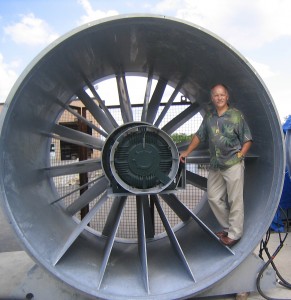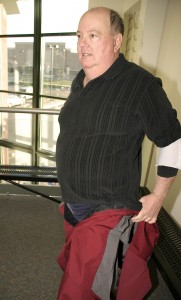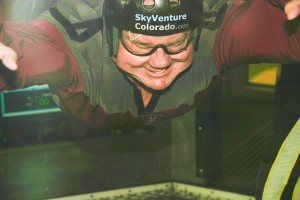
The multimillion-dollar SkyVenture Colorado facility towers above a Denver-area entertainment district.
By Jeff Mattoon
Are you a skydiver? What if you could free fall forever? What a rush. What efficiency. You could perfect maneuvers in a fraction of the time of your chums, who are limited by free-fall intervals measured in seconds-per-hour, while your free falls are measured in minutes-per-hour.
Sounds like a pipedream, right? In a way it is, but the pipe is a big one, and it has huge fans attached. It’s a wind tunnel and more specifically, a vertical wind tunnel used solely for levitating people.
About 25 years ago, an industry sprouted to float people while they gyrate in midair, practicing something that heretofore could be accomplished only by jumping out of a perfectly good, at-altitude aircraft.
Of course, we’re talking about skydiving, and more specifically, its little brother, bodyflying. Bodyflight, as far as anyone can tell, was first accomplished in 1964, at Wright Patterson Air Force Base, Dayton, Ohio, and has since been used extensively by the military. It took nearly two decades, however, before anyone stepped forward to make it a commercial venture, and from that point, the industry has steadily grown. No official industry gross revenue estimates are available, but with nearly a dozen VWTs operating in the U.S., with a half-dozen or so on the drawing board, and with multimillion dollars in construction costs, tunnel owners certainly see a tremendous opportunity to reach an underserved market.
One of those owners is Norm Rosendale of Denver. His business, SkyVenture Colorado, is “ahead of projections,” at just one year of operation.
“We attract many who are ‘just’ bodyflyers—those who’ve never jumped from an airplane,” says Rosendale. “We also attract skydivers from all over the world—Russia, Poland, Spain and Japan.”
Not bad for just crossing the 12-month point in the business. Rosendale gives credit to SkyVenture, the company that provided the technology, design expertise and licensing for the Denver VWT.
Keep an eye on your next door neighbor!
It’s a good idea to keep an eye on your neighbor, because you never know when he’ll do something that reshapes an industry. That’s what his neighbor did, and Rosendale paid attention.
It was the mid-1990s, and Bill Kitchen had just sold his business. Kitchen had invented SkyCoaster, an exciting thrill ride found at amusement and entertainment parks all over the world. It’s a simple ride that lets people feel as though they’re flying through the air like a superhero, while hanging from what seems like a string.
You could say that Kitchen had an itchin’ to revolutionize an industry—the vertical wind tunnel industry, which at the time wasn’t much of an industry. He took the proceeds from selling SkyCoaster and invested them in developing new vertical wind tunnel technology.
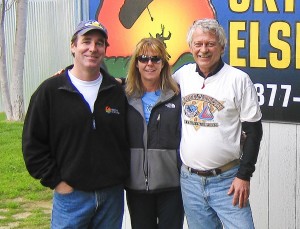
L to R: Russ Moran, Kim Smith and Jim Lawler are members of four-way Team Mayhem, which routinely uses SkyVenture Colorado to perfect their skydiving maneuvers.
Kitchen had visited a VWT, took a flight and was injured. His thoughts began to gravitate toward making the technology safer and more fun. It took him about three years to build his new design, and he placed it in the heart of one of America’s amusement havens, Orlando, Fla. The business took off instantly. People from all over the globe came to experience the Kitchen-designed SkyVenture. It offered several state-of-the-art features including fans above, instead of directly below the flight chamber. This produced a smoother wall-to-wall airflow, eliminating the possibility of falling off the column of air. The tunnel sported a mesh “floor” the staff could walk on, so novice flyers could be under an instructor’s constant supervision.
Kitchen created an activity that wasn’t suited only for the skydiver or thrill-seeker. People of all ages and from all walks of life can participate. They’re kept safe, and they have a blast in the process.
For the past decade, the designs have improved, and SkyVenture tunnels have gained a glowing reputation among bodyfliers and skydivers alike. That’s why operators like Rosendale and his partners are realizing a rapid growth in their business. Bodyfliers worldwide watch the Internet for new VWTs and initiate trips to visit new locations.
Mixed emotions
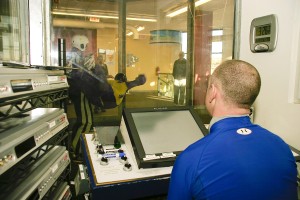
All “jumps” at SkyVenture are under the close supervision of at least two bodyflight trainers, one in the tunnel and one in the control room.
One of those watching was 47-year-old Russ Moran. Moran, currently with 175 skydiving jumps, is a member of Team Mayhem, a four-way skydiving team. He’s completely sold on the idea of using the wind tunnel for practice.
“There’s no way to achieve the same proficiency in the air over the same period of time you’re in the tunnel,” says Moran. “The ratio is about 6 to 1. For every round in the tunnel, it would take six skydives to accomplish the same amount of learning. That’s valuable time.”
Team Mayhem, which includes Moran’s girlfriend, Kim Smith, traveled to a tunnel in California, and via the Internet, watched the progress of a tunnel in Arizona, so members wouldn’t have to travel so far from their Colorado base. While keeping tabs on the Arizona tunnel, they were relieved to discover plans for a SkyVenture in Denver. Moran had mixed emotions.
“In 1997, I heard about the tunnel being built in Orlando, and I began the process of looking into building one in Colorado,” he remembers. “But, I couldn’t get investors together to make it happen. When I learned that a tunnel was being built in Denver, I wanted to be sure to support it, and I think I made the first purchase, over the Internet, of two hours worth of time.”
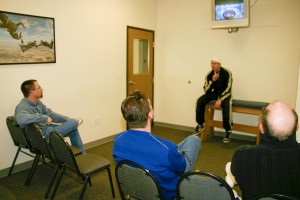
L to R: Tom, Michael and Jim Scott receive personal and video instruction before their bodyflight experience.
Because Moran is an active skydiver, he’s pleased with the location of Denver’s SkyVenture. He says many VWTs are located near airports or are in rural locations, but that’s not the case in Denver. SkyVenture Colorado is located in the entertainment district of Lone Tree, a suburb of Denver. This location provides close proximity to a major metropolitan area, making it more convenient for skydivers, and it’s also easily accessible to the public, hungry for fun and excitement.
Great Scott, this is a blast!
Jim Scott is no skydiver. He tried a few times, but it just wasn’t his cup of tea. While visiting his nephew in Las Vegas, they tried to schedule time in the VWT there, but it was either closed or totally booked. When his nephew Michael visited Scott’s home in Parker, Colo., a visit to the Lone Tree SkyVenture facility was at the top of their list.
“I’m just looking for a new experience, and this is out of this world,” says Scott. “It was actually a more fun experience than skydiving.”
Scott’s nephew had never skydived before, and was looking for that sensation.
“This was a perfect activity,” he said. “It was very exhilarating and peaceful, because I wasn’t waiting for a parachute to open.”
On a chance meeting, another unrelated Scott joined Jim Scott and his nephew. Tom Scott’s experience was quite the same.
“It was a lot more fun than I expected,” he exclaimed. “They tell you that the first go-around will last a minute. That doesn’t sound like much, but it seems to last a lot longer. The instructor flew me up in the tunnel, to where I couldn’t see the people outside the booth. It was great. I’ll definitely do this again.”
It’s people like the Scotts that Rosendale had in mind when he decided to open his SkyVenture—people with limited skydiving experience or people who have no intention of jumping out of a plane.
“Everyone wants to know what it’s like to fly, but nobody, except skydivers, wants to jump out of an airplane,” comments Rosendale. “I decided to bring the feeling of flight to everybody.”
He added that they wanted to be in the entertainment business, not just the skydiving business.
“That’s why the entertainment district in Lone Tree was perfect,” he said.
The world’s best teacher
Rosendale is no casual observer of things that float or fly; he’s been a United Airlines pilot since 1985 and has had his certificate for about 30 years. His style has always been that of observer-doer. Skiing, self-taught. Hang gliding, mostly self-taught.
When he was 20, Rosendale worked for the airlines, loading bags, all the while watching the pilots do preflight checks and thinking, “I can do that!” So, he did. He bought the books, went to school and became a mostly self-taught pilot.
Rosendale must have done something right. He’s among only about 1,000 pilots in the world to hold type ratings in the 727, 737, 747, 757, 767 and Airbuses. He seems to know about committing to a task, which is probably one of the reasons SkyVenture Colorado is ahead of projections. But, he entered the venture with eyes wide open.
“When I inquired of Bill Kitchen about getting involved in the wind tunnel business, he mildly discouraged it, because it’s a huge endeavor,” says Rosendale. “A lot of people have failed with this type of business, because of the drive it takes to make it succeed.”
While tending to his piloting duties for United, Rosendale assembled a team to build the Colorado facility. No major commercial construction task is easy, but he had enormous design issues. Rosendale, with Kitchen’s input, communicated with engineers from all over the world, to solve complex air-handling problems. Their goal was to create an extremely comfortable VWT experience, and if customers who are drawn to the facility are any evidence, the hard work has paid off.
“They’re particularly attracted to us because we have the quietest, most comfortable building of all the wind tunnels in the world,” beams Rosendale. “The other reason is that we’re in Colorado. You can fly and ski on the same day.”
Dream stream
Most entertainment seekers who visit SkyVenture Colorado have no idea how sophisticated the facility is; they simply get a kick out of floating on a steady stream of air. All the work Rosendale and company have done isn’t lost on many, however, including Jim Lawler, who’s living a dream. Now almost 60, he started skydiving about five years ago, and says it’s “the single best thing” he’s done.
“When I was in my 20s, I jumped three times, and on the last jump, I broke my ankle,” remembers Lawler. “Even so, I never got over the thrill and excitement of the experience.”
With marriage and children absorbing his time, Lawler didn’t climb back into an airplane to skydive until his 55th birthday. That birthday gift turned out to be a life-changing experience.
“Above all, the pleasure is in the relationships,” says Lawler. “At work, it’s a competitive environment, but with skydiving, I get to have some fun with people who I’d never meet otherwise. In all my experience, no one has ever withheld information that would help a person have a more enjoyable or safe experience. Without exception, they’re the finest people I’ve met in my life.”
Lawler, a petroleum engineer, loved the experience so much he joined Moran’s Team Mayhem. He was hooked.
While working toward his skydiving license, Lawler had trouble perfecting a required maneuver. Someone suggested that he travel to a VWT to practice those skills. A well-known skydiving team was conducting a workshop at the Orlando SkyVenture, and it seemed like a great opportunity to meet some new folks and gain experience at the same time. The trip proved fruitful.
“People from all over the world were there: three from England, two from Albania, one from South Africa and a few from the States,” remembers Lawler. “The experience was diverse. While I had seven skydives at the time, one guy had something like 1,100; they were all there to improve their skills. Being exposed to other people with different levels of experience allows you to learn so much.”
After retuning, Lawler “blew through” his tests and obtained his skydiving A license. He has become a passionate advocate for the VWT experience.

L to R: Tom, Michael and Jim Scott were all grins after their “flight.” Each reported a great experience.
“If you’re a skydiver who participates in competition, it’s a great way to focus on the freefall skills you need to practice,” offers Lawler. “You’re videotaped, allowing you to review your progress afterward; it’s a vital tool in obtaining skydiving efficiencies.”
Get off the bus!
Lawler is extremely pleased that SkyVenture Colorado has opened; it allows him to participate in league flying every week, for fun and practice. Skydiving and bodyflying have truly changed his life, but he gives the credit to something he read.
“A quote in a finance book talked about living life as a participant—not riding the bus, looking out the window, but getting off the darn bus and actually living as an active participant in this great life we have,” says Lawler. “That resonated with me.”
Rosendale got off the bus a long time ago. As a result, he’s helped an untold number of people live a little slice of their dreams—trying something that’s thrilling, challenging and just a whole lot of fun.
For more information, visit [http://www.indoorskydiving.org].












